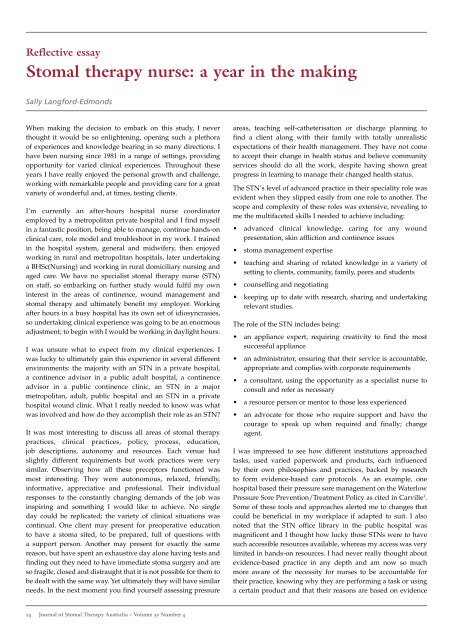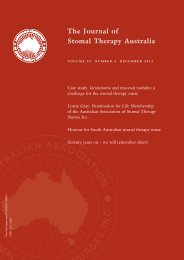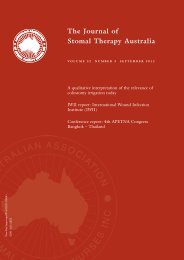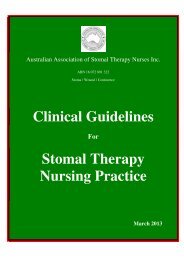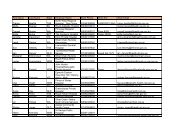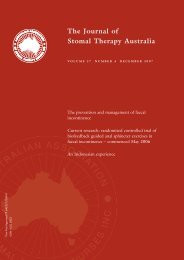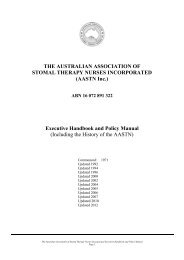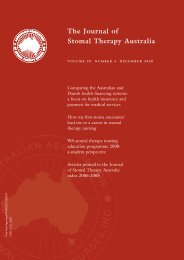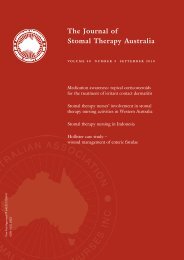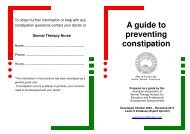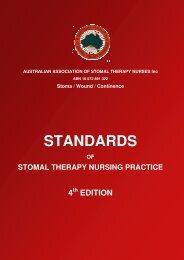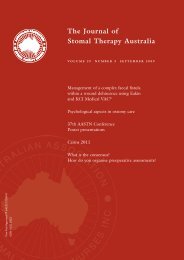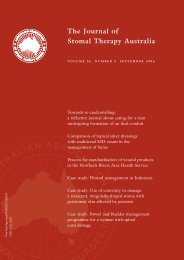JSTA December 2010 - Australian Association of Stomal Therapy ...
JSTA December 2010 - Australian Association of Stomal Therapy ...
JSTA December 2010 - Australian Association of Stomal Therapy ...
Create successful ePaper yourself
Turn your PDF publications into a flip-book with our unique Google optimized e-Paper software.
Reflective essay<br />
<strong>Stomal</strong> therapy nurse: a year in the making<br />
Sally Langford-Edmonds<br />
When making the decision to embark on this study, I never<br />
thought it would be so enlightening, opening such a plethora<br />
<strong>of</strong> experiences and knowledge bearing in so many directions. I<br />
have been nursing since 1981 in a range <strong>of</strong> settings, providing<br />
opportunity for varied clinical experiences. Throughout these<br />
years I have really enjoyed the personal growth and challenge,<br />
working with remarkable people and providing care for a great<br />
variety <strong>of</strong> wonderful and, at times, testing clients.<br />
I’m currently an after-hours hospital nurse coordinator<br />
employed by a metropolitan private hospital and I find myself<br />
in a fantastic position, being able to manage, continue hands-on<br />
clinical care, role model and troubleshoot in my work. I trained<br />
in the hospital system, general and midwifery, then enjoyed<br />
working in rural and metropolitan hospitals, later undertaking<br />
a BHSc(Nursing) and working in rural domiciliary nursing and<br />
aged care. We have no specialist stomal therapy nurse (STN)<br />
on staff, so embarking on further study would fulfil my own<br />
interest in the areas <strong>of</strong> continence, wound management and<br />
stomal therapy and ultimately benefit my employer. Working<br />
after hours in a busy hospital has its own set <strong>of</strong> idiosyncrasies,<br />
so undertaking clinical experience was going to be an enormous<br />
adjustment; to begin with I would be working in daylight hours.<br />
I was unsure what to expect from my clinical experiences. I<br />
was lucky to ultimately gain this experience in several different<br />
environments: the majority with an STN in a private hospital,<br />
a continence advisor in a public adult hospital, a continence<br />
advisor in a public continence clinic, an STN in a major<br />
metropolitan, adult, public hospital and an STN in a private<br />
hospital wound clinic. What I really needed to know was what<br />
was involved and how do they accomplish their role as an STN?<br />
It was most interesting to discuss all areas <strong>of</strong> stomal therapy<br />
practices, clinical practices, policy, process, education,<br />
job descriptions, autonomy and resources. Each venue had<br />
slightly different requirements but work practices were very<br />
similar. Observing how all these preceptors functioned was<br />
most interesting. They were autonomous, relaxed, friendly,<br />
informative, appreciative and pr<strong>of</strong>essional. Their individual<br />
responses to the constantly changing demands <strong>of</strong> the job was<br />
inspiring and something I would like to achieve. No single<br />
day could be replicated; the variety <strong>of</strong> clinical situations was<br />
continual. One client may present for preoperative education<br />
to have a stoma sited, to be prepared, full <strong>of</strong> questions with<br />
a support person. Another may present for exactly the same<br />
reason, but have spent an exhaustive day alone having tests and<br />
finding out they need to have immediate stoma surgery and are<br />
so fragile, closed and distraught that it is not possible for them to<br />
be dealt with the same way. Yet ultimately they will have similar<br />
needs. In the next moment you find yourself assessing pressure<br />
14 Journal <strong>of</strong> <strong>Stomal</strong> therapy australia – Volume 30 Number 4<br />
areas, teaching self-catheterisation or discharge planning to<br />
find a client along with their family with totally unrealistic<br />
expectations <strong>of</strong> their health management. They have not come<br />
to accept their change in health status and believe community<br />
services should do all the work, despite having shown great<br />
progress in learning to manage their changed health status.<br />
The STN’s level <strong>of</strong> advanced practice in their speciality role was<br />
evident when they slipped easily from one role to another. The<br />
scope and complexity <strong>of</strong> these roles was extensive, revealing to<br />
me the multifaceted skills I needed to achieve including:<br />
• advanced clinical knowledge, caring for any wound<br />
presentation, skin affliction and continence issues<br />
• stoma management expertise<br />
• teaching and sharing <strong>of</strong> related knowledge in a variety <strong>of</strong><br />
setting to clients, community, family, peers and students<br />
• counselling and negotiating<br />
• keeping up to date with research, sharing and undertaking<br />
relevant studies.<br />
The role <strong>of</strong> the STN includes being:<br />
• an appliance expert, requiring creativity to find the most<br />
successful appliance<br />
• an administrator, ensuring that their service is accountable,<br />
appropriate and complies with corporate requirements<br />
• a consultant, using the opportunity as a specialist nurse to<br />
consult and refer as necessary<br />
• a resource person or mentor to those less experienced<br />
• an advocate for those who require support and have the<br />
courage to speak up when required and finally; change<br />
agent.<br />
I was impressed to see how different institutions approached<br />
tasks, used varied paperwork and products, each influenced<br />
by their own philosophies and practices, backed by research<br />
to form evidence-based care protocols. As an example, one<br />
hospital based their pressure sore management on the Waterlow<br />
Pressure Sore Prevention/Treatment Policy as cited in Carville 1 .<br />
Some <strong>of</strong> these tools and approaches alerted me to changes that<br />
could be beneficial in my workplace if adapted to suit. I also<br />
noted that the STN <strong>of</strong>fice library in the public hospital was<br />
magnificent and I thought how lucky those STNs were to have<br />
such accessible resources available, whereas my access was very<br />
limited in hands-on resources. I had never really thought about<br />
evidence-based practice in any depth and am now so much<br />
more aware <strong>of</strong> the necessity for nurses to be accountable for<br />
their practice, knowing why they are performing a task or using<br />
a certain product and that their reasons are based on evidence


